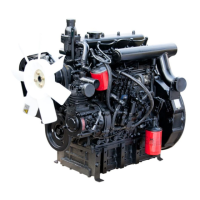MAINTENANCE MANUAL OF ENGINE
118
2.2 Introduction for components
Composition:
Engine body components: cylinder block, cylinder
liner, cylinder head, cylinder gasket and oil sump
and etc.
Piston connecting rod components:
Piston, piston ring, piston pin, connecting rod and
etc.
Crankshaft flywheel components:
Crankshaft, flywheel and etc.
Function:
Piston:
It withstands the gas pressure, and make the
crankshaft rotated through the piston pin and con-
necting rod.
Working conditions : The force exerted to the
piston includes gas pressure and reciprocating iner-
tia force. The piston crown directly contacts the
high temperature combustion gas to get the piston
crown hot. Under action of the side pressure, the
piston slides along the cylinder wall surface at high
speed. If the poor lubrication condition,the friction
loss is huge and the wear is serious.
Piston ring:
The gaseous ring is mainly used to obtain an
excellent sealing effect and heat transmission.
The oil ring is mainly designed to remove the
excessive engine oil splashed to the cylinder wall,
and form a uniform oil film on the cylinder wall.
Piston pin:
The piston pin is used to connect the piston to
the connecting rod, and transmit the force endured
by the piston to the connecting rod, and vice versa.
It will sustain a huge cyclical impact load in
high temperature condition, and because the piston
pin oscillates within a small angle range, it is diffi-
cult to form a lubricating oil film, obtaining a poor
lubricating condition.
Connecting rod:
It transmits the force from the piston to the
crankshaft, and converts the reciprocating motion of
the piston into the rotary motion of the crankshaft.
Connecting rod bearing:
It is designed to protect the connecting rod
journal and connecting rod big end hole.
Crankshaft:
Convert the gas pressure transmitted from the
piston connecting rod component to the output
torque. Then, it is used to drive the valve mecha-
nism of the engine and other devices.
Working conditions: It is impacted by the gas pres-
sure, inertia force, inertia torque and varying load.
Thrust plate:
It is used to ensure that the crank-link mecha-
nism can operate normally when the crankshaft
withstands an axial force.
Flywheel:
In the power stroke, partial power delivered to
the crankshaft is stored to overcome the resistance
force produced in other strokes and drive the
crank-link mechanism to overpass the upper and
lower dead points, so as to ensure that the rotational
angular velocity and output torque of the crankshaft
can be kept constant as far as possible, and the en-
gine is able to overcome short-time overload and
the power produced from the engine is delivered to
the clutch.

